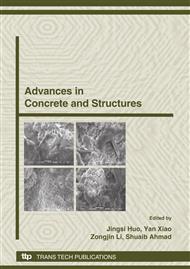p.513
p.519
p.525
p.531
p.537
p.543
p.551
p.559
p.567
Study on Combining Performance of Young and Old Concrete with Mechanical Joint Element
Abstract:
The new way of using mechanical joint element (MJE) to cross the interface of new and old concrete to reinforce the combination is put forward. The splitting strength tests of young and old concrete were carried out to investigate the effects on splitting strength of MJE and different materials used to embed the MJE. The working mechanism of the MJE in split test is discussed emphatically. The shear tests of young and old concrete were carried out too. The effects on shear strength of MJE and interface agent are discussed. The mechanism of MJE in shear test is analyzed synchronously.
Info:
Periodical:
Pages:
537-542
Citation:
Online since:
October 2008
Authors:
Price:
Сopyright:
© 2009 Trans Tech Publications Ltd. All Rights Reserved
Share:
Citation:


